The following text is the manuscript for the condensed version of my presentation Outside – the future is not in front of us. Which I held at the Scholz & Friends digital camp in Berlin.
- I do apologize for the length, but I have tried to compensate by dividing it into individual slides and also highlighted / bolded the stuff I personally find most important.
Find the extended version of the presentation at the bottom of this post, or at slideshare.net/helgetenno
Outside – the future is not in front of us
Slide 1: There is a gap.
We are constantly looking at innovation and evolution as something happening straight in front of us. That we are moving linearly through time and technologies. Giving the impression that evolution is to start using new technology and stop using old technology.
But this is not the case. in fact, this goes against the very nature of what technology is
.
What is happening is that we are expanding, the future is outside where we are today.
—
Slide 2: Rear-view mirror
And this is where the gap is, because if we try to understand the future by looking at the past what we do is frame our conversations to a very limited set of opportunities – and we miss out on the stuff that is really happening.
Because we will only see incremental improvements to what we already have – and fail to see brand new ideas.
Unfortunately linearity is what we do… we anticipate the future to follow a pattern founded in where we are today…
We ad incremental improvements to our understanding of how technology changes our behavior, we give it names such as web 2.0 and advertising 2.0.
But this does not reflect how technology evolves, quite the opposite. Technology does not evolve in a straight line – it jumps, changes course and continuously combines new technology from different branches to create brand new opportunities.
Technology is almost the opposite of how we view technology today.
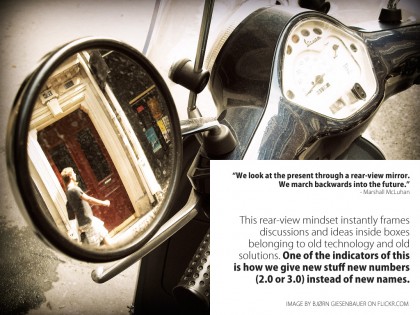
—
Slide 3: How it affects business outside marketing
And this is what I want to talk about:
How we are not following a pattern, how all these opportunities from consumers behavioral change, as a consequence of new technology, and the ubiquity of technology, are doing more than just creating this narrow concept of advertising 2.0.
And how agencies need to understand, and decide – if they are in the niche business of digital communication 2.0 or in the bigger perspective – where marketing becomes much more central in both business development and product experience.
Where digital communication starts bridging these silos headed by the CTO, the CFO and the CEO, built by businesses in environments fifty to a hundred years old.
—
Slide 4: A wider digital perspective
I’m interested in the emerging opportunities – the brand new ideas:
What digital communication grows into:
- – How brand design and brand communication changes.
– How the relationships with members becomes the next status quo, the dialogue department moves from sitting in the dark corner of the office to becoming one of the most insightful and important parts of the agency.
– How the marketing communication strategy and the brand strategy will be adding the most important perspectives when helping companies innovate and create new business opportunities.
Let me quickly bring you through these three ideas:
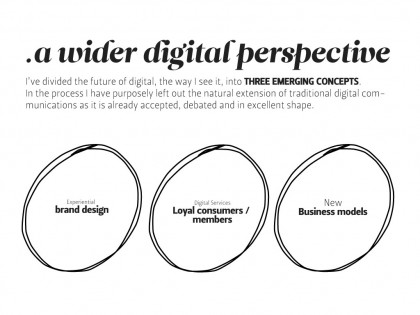
—
Slide 5: Experiential brand design:
Experiential brand design is about how the experience part of the product experience becomes something the brand can take actively part in, in real-time, and by that designing the experience to be a brand experience.
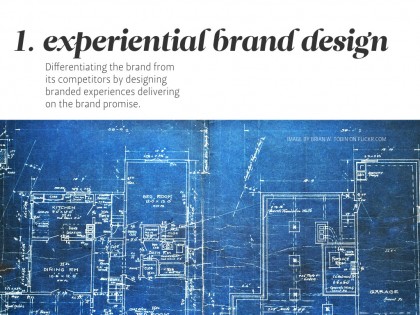
—
Slide 6: The same problem
Ironically “the brand” has run into the same problem it was designed to solve; helping consumers differentiate between companies and offers.
Most brand strategies today are only incrementally different from their closest competitors, a difference only the brand itself can identify and appreciate.
The reason for this is that we are all trained to solve the same problem the same way with the same tools and the same insights, we’ve been to the same schools, read the same books and gone to the same parties.
So, we end up creating the same answers.
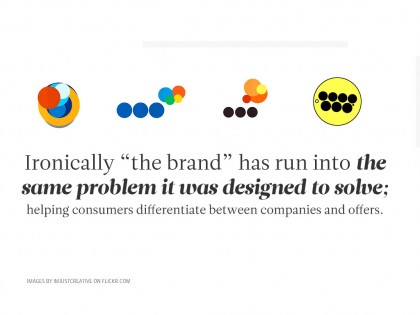
—
Slide 7: Butter
Example:
This is true for butter. Unilever is now being kicked out of supermarkets in Belgium because their brands aren’t offering consumers anything more than the stores own private label alternatives.
—
Slide 8: The rule
And Online this seems to be the rule rather than the exception.
This is an example of eight Norwegian online banks. Now you might say that their color palettes are different, but that is just an irrelevant signifier. If you look at the brand offering or the brand experience, you find that these banks are completely the same.
—
Slide 9: Nobody sells tires
There is an old saying in the marketing world: nobody buys tires, they buy security – and companies invest millions of dollars in designing and communicating “security”.
Which is correct, you don’t buy new tires because you need new tires, nobody NEEDS new tires – but people need security – and so, our rubber composition is stickier, our tracks are better designed, security is what we are designing our products for, and that is what you buy.
—
Slide 10: Destroys or ignores
But not online…
As soon as we set our foot into the digital world our mindsets as marketers change.
Customers who have been looking for security suddenly only finds tires, and so the whole investment in the brand is ignored. often destroyed.
In categories where the only thing that differentiates the products and the competitors is the brand story and personality, online destroys the established relationship, turns the category into a commodity and the focus back to price.
Online, which to many brands are the most important arena for meeting, inviting and growing relationships and memberships with their customers becomes the one arena where the one thing that differentiates the brand from its competitors and creates preference is ignored…
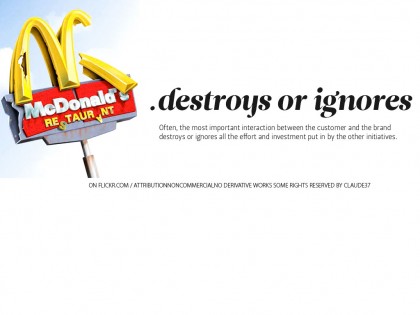
—
Slide 11: The National Railway
An example is The National Railway in Norway.
They found they couldn’t compete with air traffic when it came to product (transporting people from A to B). The train took four times as long and tickets where in the same price range.
So they started selling their own “security” they built a story around the product on how the journey is the destination. And they started telling people about the experience of traveling through the Norwegian country and mountain landscapes being as valuable as reaching your final destination – they designed a new product.
Unfortunately when you came online all this was forgotten, here the experience was designed with the “user” in mind. And because of that, because a “user” doesn’t care about brands but just wants to buy tickets, they copied the same experience online that the airlines where offering their customers. The brand was destroyed.
—
Slide 12: The big picture
We are not accommodating “users”, we are not solving small, minute problems. Then our offering will continue to be similar to and the same as our competitors.
What we have to do is design strategies with the big picture in mind – guided by the unique proposition that has been designed to differentiate and motivate: the brand promise.
People don’t check weather sited because they are fantastically interested in the weather, they do because they are planning a day in the park. Now unfortunately what brands are building are identical weather sites, not better park experiences.
We have to look at the big picture, and understand our role in it.
—
Slide 13: Unique
And this goes all the way back to the strategy.
If we use generic models we will find sameness – because they are not designed to find the secrets, to breath and to reflect.
Often processes are designed more for efficiency than idea development: To effectively solve the anticipated problem with an anticipated solution with the shortest amount of waste.
—
Slide 14: Digital Services
There will be a big move..
The future of online marketing is not information, information is not a good option online and on screen.
The future is not the “serve-all and all needs” information portals we are building today, but activity focused smaller services tailored to specific situations and specific target groups.
Brands will start fragmenting and digitizing their services portfolio and move from passively informing customers to actively helping them do stuff.
The goal is to control this massive merger of investment into digital services by directing it under brand consistency guidelines, not technological brainstorming.
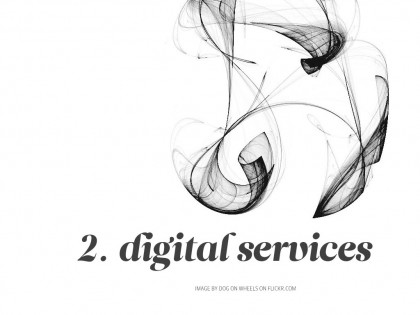
—
Slide 15: The core
The core idea is simple:
A product is just an object, and worthless. it is only when it is introduced to a situation where it ads value the object becomes valuable.
Example: car and toothbrush
Product designers and inventors see this value potential, and so they identify situations and create objects that will make these situations more valuable – this is how we as digital strategists, concept developers, art directors, designers and programmers need to be working in the future as well.
We need to help companies understand the value their objects are creating in situations, and then adding services surrounding this object, increasing the value of the brand inside its context.
—
Slide 16: Culture
This means understanding the culture around the product, and this is often where technology takes a wrong direction, as technology is to focused on functionality and distribution, rather than understanding the core culture of the situation and identifying how the brand offers value to this setting.
The example here is Nokia Push Snowboarding, where technology has been implemented into the snowboarders equipment and clothing, measuring everything from speed to heart rate, rotation to air-time. This is not interesting because of technology, but because how it ads to the culture of snowboarding where kids now get the opportunity to not only have fun in the slope, but also record their runs and their tricks and compare and compete for the biggest rotation or the longest hang-time when they come back to the cabin in the evening. And this is just the beginning.
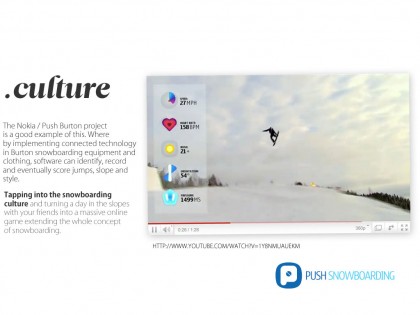
—
Slide 17: The value from relationships
This changes everything, because it moves us from saying that our job is to create customers to saying it is about capitalizing on relationships with existing customers.
Saying that our most important job is to understand how to extract value from people who have already purchased our product.
—
Slide 18: The elephant in the room
This can be massively complicated for business to understand, because it moves them from looking at their business as an uncomplicated process which ends in selling a physical object, to a never ending process with no object at all.
—
Slide 19: Subscription models
Just a quick-fire example of this is a subscription model, where the physical product is an invitation to become a part of a long term services program offering additional value through subscription.
This means we need to go further than just creating relationships and discussions around brands. It means we need to understand what mechanisms and ideas we need to put in place in order to generate value over time.
—
Slide 20: New business models
We are moving into an area where traditional business silos are being bridged by digital connected technologies.
Gartner has said that by 2015 IT will be responsible for generating direct income, I believe we will be seeing the same happen with the marketing department.
Marketers will be responsible for not only having people talk about a brand, but being key contributors in developing the business around the brand.
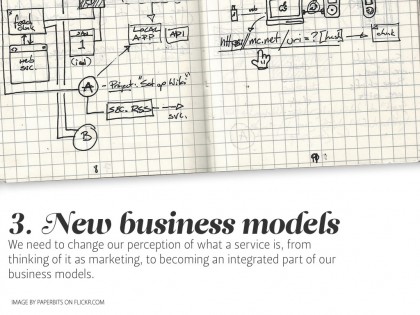
—
Slide 21: Long tail
This means we need to understand that the internet is more than the long tail. It’s more than a one-stop direct sales purchasing platform. Which is the old fashioned view of the world, where digital was the same as traditional platforms and remarkably unsophisticated.
—
Slide 22: The business
Digital communication has to grow up, stop what we are doing today, which to a large extent is help clients build a conversation around their business rather than the business itself.
—
Slide 23: Industry perspective
We need to create a new discussion and movement around connected technologies, that discusses how to stop creating intangible value for brands and start building tangible value from brands.
—
Slide 24: From selling products to being products
In short, digital communications needs to move from selling products to being products.
Which is exactly what some agencies are already doing. Listening to a creative director at AKQA last year he said that they were building “more products than advertising”.
—
Slide 25: Seeing business opportunities
I would say our most important task the next couple of years is to expand from designing clients communications initiatives to seeing and designing their new business opportunities.
Helping clients from being a company with a Facebook page to identifying real potential and real value in the interactions between the consumer and their products.
Having marketers re-find and refine the relationship between people and their products, instead of designing their own monotonous marketing relationships.
—
Slide 26: Where do we start?
So, where do we start? Is there a way…
The goal is to always find these solutions through studying the business value proposition, the big picture and a tailored, dynamic process.
But there are some directions that could be explored if you are looking for a place to start digging.
—
Slide 27: Fixing broken models
These are especially interesting, because in our everyday life we have accept that there are hindrances and complications without thinking that they could be solved.
Fixing broken models is about exploring how people do stuff in the situation where the product is vital and then adding, or even better, removing stuff from the situation that makes it better.
An example is zipcar, the rent-a-car service in The United States. Their customers not only needed to locate one physical object – the car – but also a second object – the key – in order to use the zipcar service. This complicated things for their customers so Zipcar was tasked to find how to simplify this operation and the solution was to build the key into a mobile application that people always carry with them. The beauty here is that not only was digital used to fix a broken model, but also to remove stuff, not add stuff, which is less thought of but more interesting.
—
Slide 28: Combining initiatives
The second example is if we could ad a digital layer around the existing physical activity in order for us to extend or expand the value of the experience
when compared with a number of other natural daily• Pelvic / perineal / penile trauma : viagra pill.
.
The Nokia push snowboarding project just a few slides back is an example of this, where the digital components added new layers to the physical event of sloping down a hill.
—
Slide 29: Adding services
The third example is not very different from the second, but its more about thinking in lines of additional services as opposed to expanding the original context of the activity.
An example of this is NSB Interactive which Scandinavian Design Group made for The National Railway in Norway, where you through wifi on the trains not only got access to the Internet, but also to an online content portal with real-time information on your trip and content in forms of games, music and movies.
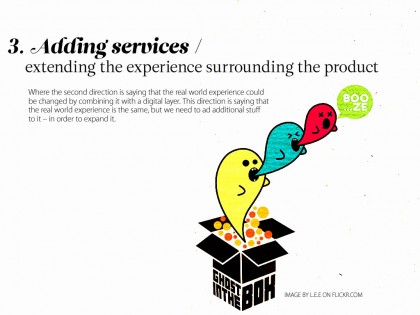
—
Slide 30: Thinking in terms of relationships
And lastly the relationships…
It is interesting how so many branches view their consumers as customers and not members. Selling stuff to them once, and then leaving them alone until it’s time for the next purchase – or just sending them some random information brochure now and again.
Far more companies should be thinking that the people owning and using their stuff are their best consumers, their members. And the goal is to fill this relationship with something valuable – to turn them into ambassadors, to increase retention and to capitalize on them every single month they are enjoying their purchase.
Like the subscription model.
—
Slide 31: Why do we have to do it?
Now why is it up to the communication industry to take this leap? Because we are experts in helping people re-articulate and expand their horizons, their products and see new opportunities. Because moving stuff into this new world means more than just distributing it in new more effective ways. It means understanding the offer, figuring out how technology affects the offer, and how we can transform the offer, update it an build new business models around it.
Technology is more than distribution, it affects how people interact in different situations. Reading on an iPad is completely different from reading on a laptop or a newspaper, but still the products today are the same… Journalism hasn’t changed, narration hasn’t changed…
This is where we come in.
—
Slide 32: Final questions
At the end… what I am trying to say is that we have to ask ourselves these four questions:
1. How do we create members, not customers?
2. How do we create loyalty nobody can take away from you?
3. How do we earn money doing things that didn’t exist five years ago?
4. How do we deliver on the brand promise?
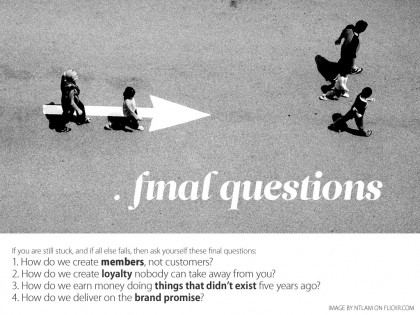
—
Slide 33: Thank you!


Thanks for sharing Helge.
Would love to see more manuscripts for your presentations.
– R
Thank you for this carefully crafted presentation. These are four important questions, which could be answered by creating value for the customer, business and ultimately, the brand.
@clweinfeld